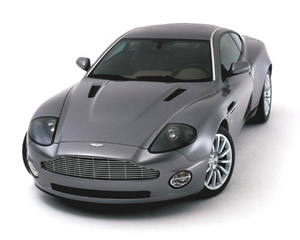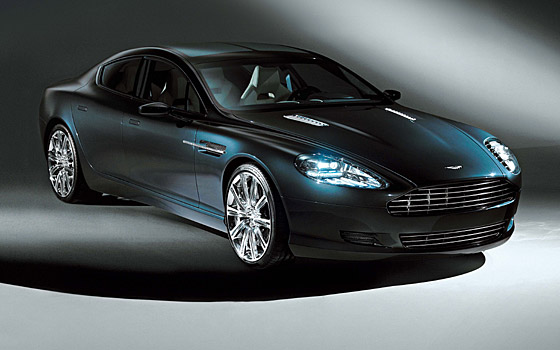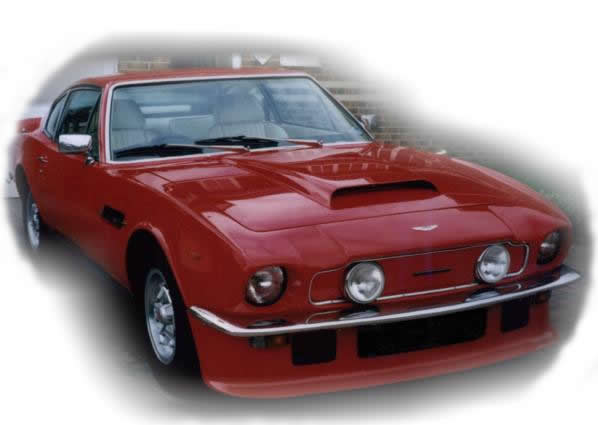![]()
Aston-Martin or Aston Martin?
The Badge
There have been four styles of badge (see below). Lionel Martin built cars were graced with a small circular badge featuring the letters AM neatly superimposed. A die-cast emblem was the adopted from 1928, in which the full name was set against a pair of wings.
During 1930 a new version of the winged badge was introduced, which being a pressing, could be plated with the radiator shell. The first samples of a new enamelled badge appeared shortly after the introduction of the Second Series early in 1932. Although still of the winged variety, the new design bore no resemblance to any previous type, the wings being more angular and of a symbolic nature, whilst the name Aston Martin was inserted in a central panel, complete with the hyphen.
The enamel badges didn't appear on production models until the introduction of the Mark II model in 1934, and became standardised. The David Brown addition was used from the DB2/4 to the end of that era, and with only minor variations, has remained in use to the present day.

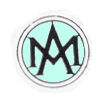
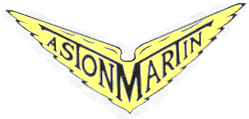

(Colours for illustration purposes only)

![]()
Click on the model to see more details on the following Aston Martin's:
Aston Martin International
Aston Martin International Le Mans
Aston Martin Le Mans
Aston Martin 12/50 Standard
Aston Martin Mk II Long
Aston Martin Mk II Short
Aston Martin Ulster
Aston Martin 2-Litre Speed Model
Aston Martin 15/98 Long
Aston Martin 15/98 Short
Aston Martin 2-Litre C-Type
Aston Martin Two-litre Sports
Aston Martin DB2
Aston Martin DB2/4 Mk1
Aston Martin DB2/4 Mk2
Aston Martin DB Mk III
Aston Martin DB4
Aston Martin DB4GT
Aston Martin DB4 Drophead Coupe
Aston Martin DB4GT Zagato
Aston Martin DB5
Aston Martin DB6
Aston Martin DBS
Aston Martin DBS V8 Series 1
Aston Martin V8 Saloon
Aston Martin Lagonda
Aston Martin Vantage/Volante Vantage
Aston Martin Volante
Aston Martin Zagato
Aston Martin Virage
Aston Martin V8 Vantage
Aston Martin DB7 Coupe
Aston Martin DB7 Volante
Aston Martin V8 Coupe
Aston Martin V8 Volante
Aston Martin DB7 Vantage V12
Aston Martin DB7 Vantage Volante V12
Aston Martin Vanquish
Aston Martin Rapide
Aston Martin International
1929-1932
Saloon (2 door, 4 seater)
Coupe (2 door, 2 seater)
Drophead Coupe (2 door, 2 seater)
production: 81
Aston Martin International Le Mans
1932
Sports (2 door, 2 seater)
production: 12
Aston Martin Le Mans
1932-1934
Sports (2 door, 4 seater)
production: 72
Aston Martin 12/50 Standard
1933-1934
Saloon (2 door, 4 seater)
production: 20
Aston Martin Mk II Long
1934-1936
Sports (2 door, 4 seater)
Drophead Coupe (2 door, 2 seater)
production: 61
Aston Martin Mk II Short
1934-1936
Sports (2 door, 2 seater)
production: 56
Aston Martin Ulster
1934-1936
production: 24
Aston Martin 2-Litre Speed Model
1936-1938
production: 13
Aston Martin 15/98 Long
1937-1939
Saloon (4 door, 4 seater)
production: 50
Aston Martin 15/98 Short
1937-1939
Drophead Coupe (2 door, 2 seater)
Sports (2 door, 2 seater)
production: 75
Aston Martin 2-Litre C-Type
1939
production:5
Aston Martin Two-litre Sports
1948-1950
production: 14
Only 14 of these beautiful convertibles were ever produced from 1948 to 1950. Retrospectively known as the DB1, this car was the first produced by Aston Martin since it had been purchased by David Brown (later Sir David Brown).
The Two Litre Sports was powered by a 1970cc, pushrod four cylinder engine, producing 90bhp. The car had independent front suspension and featured spare wheel compartments in the front wings. This attractive sports car was replaced in 1950 by the more successful DB2 .
Engine Capacity: 1970ccType: 4 cyl OHV
Power: 90bhp
Aston Martin DB2
1950-1953
Convertible (2 door, 2 seater)
production: 411
The first of Astons "DB" series of road cars to be sold with the famous initials (Two-Litre models were retrospectively called DB1, only 14 produced). The car was powered by the Twin-cam, W.O. Bentley designed Lagonda engine , developing 116bhp in standard form and 125bhp in "Vantage" guise.
A distinctive design offered in both two seater Coupe and Drophead Coupe form. Only 411 cars produced in total but still available for a lot less than the later DB series cars.
Engine Capacity: 2580ccType: 6 cyl DOHC
Power: 116bhp@5000rpm
Top Speed: 117mph
0-60mph: 11.2 seconds
Aston Martin DB2/4 Mk1
1953-1955
Coupe (2 door, 4 seater)
Convertible (2 door, 4 seater)
production: 565
An elegant follow on from the DB2 , now with a four seater (2+2) Saloon (Coupe) or Drophead Coupe body, featuring a much cleaner nose design than before. Early cars have 2.6 Litre Vantage spec engines , later cars (from 1954) have a more powerful 3 Litre engine that compensates for the extra weight.
The DB2/4 MK1 can be considered a practical car, Saloons have an early form of "hatchback" rear window and the later 3 Litre cars boast 140bhp. Only 73 Dropheads were made so values reflect the rarity but saloons are still easy to find.
Engine Capacity: 2580cc or 2922ccType: 6 cyl DOHC
Aston Martin DB2/4 Mk2
1955-1957
Coupe (2 door, 4 seater),
Convertible (2 door, 4 seater)
production: 199
Same mechanically as the DB2/4 Mk I , but now has a square rear wing profile. Still available as "hatchback" Saloon or Drophead Coupe but an additional "notchback"/ "hardtop" style saloon joins the range
(only just over 30 of these were made).
Late Mk II's featured a higher performance engine with larger valves and different cam shafts, delivering around 165bhp
Engine Capacity: 2922ccType: 6 cyl DOHC
Power: 140bhp@5000rpm
Top Speed: 120mph
0-60mph: 11.1 seconds
Aston Martin DB Mk III
1957-1959
Coupe (2 door, 4 seater)
Convertible (2 door, 4 seater)
production: 551
The Final derivative of the DB2 family, featuring a restyled front end and front, Girling disc brakes. Other updates included a hydraulic clutch, overdrive and automatic transmission options.
Available in Saloon (4-seater Coupe) or Convertible body styles, standard engine has 162bhp and 120mph top speed, also other engine options available. In some respects not the prettiest of post-war Astons but normally valued slightly higher than earlier DB2 models.Engine Capacity: 2922cc
Type: 6 cyl DOHC
Power: 162bhp@5500rpm
Top Speed: 120mph
0-60mph: 9.3 seconds
Aston Martin DB4
1958-1963
Saloon (2 door, 4 seater)
production: 1040
The first of the very successful DB4/ 5 / 6 line-up, featuring elegant coachwork designed by Touring of Milan, Italy. The handmade, aluminum bodywork panels were mounted on a steel tube frame, using the Superleggera (meaning: super light) method of construction. All round disc brakes fitted, made first by Dunlop and later on by Girling.
There were five series of the DB4, each series introduced changes and improvements to the original series one cars. Early cars have a mesh grille and simpler bumper design. Later cars are longer and consequently heavier than early cars, some late series five cars had DB5 style headlamp covers.
All DB4s were powered by a new six cylinder, all aluminum, 3670cc engine designed by Tadek Mereck, developing around 220bhp - 240bhp.
The DB4 offered excellent performance for the time, 140mph top speed and 0-60 in 8.5 seconds. Overdrive transmission on most cars, the gearbox was produced by Astons' owner, David Brown. A Vantage engine was also available, offering even higher power outputs.Engine Capacity: 3670cc (Vantage 3750cc)
Type: 6 cyl DOHC
Power: 220bhp@5500rpm (Vantage 240bhp@5500rpm)
Top Speed: 141mph
0-60mph: 8.5 seconds
Aston Martin DB4GT
1960-1963
Coupe (2 door, 2 seater)
production: 75
The DB4GT offered even greater performance than the standard DB4 Saloon . First introduced in 1959 the DB4GT had a short wheelbase body and a revised six cylinder engine which now had twin distributors (with twin spark plugs per cylinder) and triple twin choke Weber Carbs, producing a staggering 302bhp.
The extra performance from the DB4GT engine now resulted in a increased top speed of 153mph and a 0-60 time of just over six seconds. Due to the cars shorter wheelbase no rear seats were included in the DB4GT, an extra luggage platform was included instead. Another identification point is that all DB4GTs had Perspex headlamp covers and exposed racing style fuel filler caps on the rear wings.
Just 75 true DB4GTs were produced from 1959 until 1963, excluding 19 GTs which were bodied by Italian coachbuilder ZagatoEngine Capacity: 3750cc
Type: 6 cyl DOHC
Power: 302bhp@6000rpm
Top Speed: 152mph
0-60mph: 6.4 seconds
Aston Martin DB4 Drophead Coupe
1961-1963
Convertible (2 door, 4 seater)
production: 70
First introduced in 1961, the DB4 Convertible reflected the then current DB4 Saloon series four, using the same six cylinder, 3670cc engine now producing 260bhp. Some 32 DB4 Convertibles were built with Vantage specification engines, overdrive gearboxes were also listed as factory options.
The DB4 Convertible also shared the Saloons Aluminum, Superleggera body construction but now featured a fully lined convertible top, which looked well proportioned in its raised position.
Whilst the DB5 is well known as the "James Bond car" we should not forget the DB4 Convertible's role in the film, The Italian Job. In this cult 60s film, Michael Caine's DB4 Convertible, met a nasty end after being pushed over a cliff by a Mafia Bull Dozer!, luckily a good number of these important post war Astons now survive.Engine Capacity: 3670cc
Type: 6 cyl DOHC
Power: 260bhp@5500rpm
Top Speed: 140mph
0-60mph: 8.5 seconds
Aston Martin DB4GT Zagato
1961-1963
Coupe (2 door, 2 seater)
production: 19
An incredible car when first launched at the 1960 London Motor Show, designed to beat Ferrari on the race circuit!. The DB4GT Zagato body was built on the shortened chassis of the "standard" DB4GT , very light in weight and entirely handmade by well known Italian coachbuilder Zagato.
DB4GT Zagato performance can only be described as staggering, with a 160mph top speed coming from an engine producing 314bhp. The DB4GT Zagato had a distinguished competition history with many victories both at hone and abroad.
Only 19 cars were originally produced between 1959 and 1963, another batch of cars were produced in the late 1980s by well known Aston Martin specialist, Richard Williams, with the assistance of the Aston Martin factory, using up unused chassis numbers.Engine Capacity: 3670cc
Type: 6 cyl DOHC
Power: 314bhp@6000rpm
Top Speed: 160mph
0-60mph: 6.1 seconds
Aston Martin DB5
1964-1965
Saloon (2 door, 4 seater)
production: 1021
Perhaps the best known Aston Martin of all time, due to its starring role in the James Bond film, "Gold Finger", the DB5 was produced only from 1964 to 1965, a total of 1021 cars were built. The bodywork is similar to the series five DB4 Saloons , although due to extra equipment the weight had risen dramatically.
The straight six, Tadek Mereck designed engine now displaced some 3995cc. All but the first DB5s had a new ZF five speed gearbox and other luxuries such as adjustable, Selectaride type Armstrong Dampers and electric windows. Standard engined cars had 242bhp, with Vantage engined cars having 314bhp, enough extra power to compensate for the cars heavier kerb weight.
As well as being produced in saloon form the DB5 was also available as a convertible, in a similar style to the DB4 Convertible. A more unusual DB5 derivative was the conversion by coachbuilder Harold Radford, the DB5 Shooting Brake, only 12 cars were produced.
Engine Capacity: 3995ccType: 6 cyl DOHC
Power: 242bhp@6000rpm (Vantage 314bhp@6000rpm)
Top Speed: 143mph
0-60mph: 8.1 seconds
Aston Martin DB6
1965-1970
Saloon (2 door, 4 seater)
production: 1567
Following on from the success of the DB5 , the DB6 first entered production in 1965 and was to run well into 1970, being produced side-by-side with the DBS at the Newport Pagnell factory. DB6 MK2 introduced in 1969, featuring flared wheel arches and standard power steering.
The DB6 bodywork had a new tail design, offering improved aerodynamics and also had a revised rear 1/4 windows and a higher rear roof line. Options now included power steering (on MK1 cars), air conditioning, automatic transmission, limited slip differential and a 325bhp Vantage engine option.
A convertible body style was also offered, as was the normal Aston tradition, although now called "Volante", a name still used by the company today. Early (1965-1966) DB6 Volantes had a "short chassis" body, only 37 were produced and are distinguished by a shorter tail. A handful of "Shooting Brakes" were also produced by British coachbuilder Harold Radford.Engine Capacity: 3995cc
Type: 6 cyl DOHC
Power: 270bhp@6000rpm (Vantage 325bhp@6000rpm)
Top Speed: 146mph
0-60mph: 6.0 seconds
Aston Martin DBS
1967-1972
Saloon (2 door, 4 seater)
production: 860
First launched in 1967 the DBS featured an all new body, designed by William Towns (who later designed the AM Lagonda in 1976) which featured a distinctive four headlamp grille and a much squarer, more transatlantic shape than seen before on the other DB cars.
Originally designed to accept an all new V8 engine, unfortunately this was not ready in time for the cars launch, so it had to make do with the tried and tested DB6 engine . Due to the increased weight of the DBS body, performance dropped resulting in a 140mph top speed and a 0-60 time of 8 seconds. The DBS was eventually replaced by the DBS V8 , although confusingly a single headlamp car known simply as a Vantage, was also produced alongside the AMV8 but featuring the straight six DBS engine .Engine Capacity: 3995cc
Type: 6 cyl DOHC
Power: 325bhp@6000rpm
Top Speed: 143mph
0-60mph: 7.1 seconds
Aston Martin DBS V8 Series 1
1969-1972
Saloon (2 door, 4 seater)
production: 405
Aston Martin finally launched the DBSV8 at the end of 1969, after a longer than anticipated development plan. The wait was obviously worthwhile as the engine is still in production today, albeit in heavily modified form. The new twin cam V8 engine produced a staggering 345bhp in standard form, enough to propel the car to a top speed of 160mph, unbelievable for an early 1970s car weighing nearly 2 tons!
Made only as a Saloon the DBSV8 can be identified by its twin headlamp grille and cast aluminum road wheels, which replaced the DBS 6 cylinders wire wheels. Most cars had automatic transmission although a manual ZF gearbox could also be specified, this manual box suffered because of its heavy clutch. An important car in Astons history that offers real super car performance in an almost transatlantic way.Engine Capacity: 5340cc
Type:V 8 with 4 OHC
Power: 345bhp@6000rpm
Top Speed: 162mph
0-60mph: 5.4 seconds
Aston Martin V8 Saloon
1972-1990
Saloon (2 door, 4 seater)
production: 1509
Launched in 1972 to replace the mechanically identical DBSV8 , the Aston Martin V8 (or AMV8) became Astons' best seller until 1995 when the DB7 was launched. Produced until 1990, the AMV8 had many specification changes, some cars had fuel injection whilst others had Weber Carburetors.
Later cars had wood trimmed interiors and large grille mounted auxiliary driving lamps, overall reliability and production quality improved after 1975. Production finally ended in 1990 when the Virage entered production. An unusual variant was the 1974 Lagonda , which was basically a stretched 4 door V8 saloon, only 7 of these cars were built up until 1976.Engine Capacity: 5340cc (and upwards)
Type:V 8 with 4 OHC
Power: 375bhp@6000rpm (and upwards)
Top Speed: 155mph (and upwards)
0-60mph: 5.4 seconds (and quicker!)
Aston Martin Lagonda
1974-1976 (1990)
Saloon (4 door, 4 seater)
production: 7 (600)
When launched at Woburn Abbey in 1976 the Aston Martin Lagonda had futuristic looks and almost space aged electronics for the time. The Lagondas William Towns designed, four door, pop-up headlamp bodyshell enclosed the fuel injected 5.3 litre Aston Martin V8 engine and was capable of carrying four passengers in comfort at speeds approaching 145mph.
The cars electronics featured red LED displays and touch-sensitive switch gear at first, moving on thru TV monitor displays to finally a LED instrument binnacle. The cars facia also had a "talking" computer and many other "gadgets" were often fitted for individual owners. Early cars suffered from electrical problems and interestingly had fixed rear door windows!
The car lasted into late 1990 in a facelifted format, many cars were exported to the overseas markets including the Middle East.Engine Capacity: 5340cc
Type:V 8 with 4 OHC
Top Speed: 150mph
0-60mph: 10.0 (seconds)
Aston Martin Vantage/Volante Vantage
1977-1989
Convertible (2 door, 2 seater), Saloon (2 door, 4 seater)
production: 428 (313 Saloon 115 Volante Vantage)
In normal Aston Martin tradition the AMV8 family grew to include a Vantage (higher performance version) and from 1986 a Vantage Volante (convertible) version was also added to the range.
The Vantage had a 438bhp version of the standard 5340cc V8 engine, this was enough to propel the car to a top speed of 170mph. Recognizable by its spoilers and blanked-out radiator grille the car had various wheel and styling changes throughout its life. If the standard performance was not enough, the factories Service Department also converted some cars to a 6.3 litre specification!.
The V8 Vantage Volante had the same mechanics as the saloon but with the V8 Volantes convertible coachwork. Most cars had dramatic looking flared wheel arches and side skirts. HRH Prince Charles ordered a car with out the flared arches and side skirts, which led to a handful of replicas known as "The Prince of Wales" specification.Engine Capacity: 5340cc
Type:V 8 with 4 OHC
Top Speed: 168mph
0-60mph: 5.9 (seconds)
Aston Martin Volante
1978-date
Convertible (2 door, 2 seater)
production: 800
In 1978 Aston Martin finally unveiled its V8 Volante model. Based on the AMV8 Saloon , the Volante had the same basic body shell (which had been strengthened) but with a power operated hood instead of the Saloons roof. Rear wings and boot lid were also different to suit the new roof design.
Power came from the same 5340cc engine as the Saloon with either 5 speed manual or automatic transmission. Wood Veneer trim made its Aston Martin debut on the V8 Volante, indicating its role as a sportier alternative to the Rolls-Royce / Bentley Corniche .Engine Capacity: 5340cc
Type:V 8 with 4 OHC
Top Speed: 130mph
0-60mph: 7.0 (seconds)
Aston Martin Zagato
1986-1987
production: 75
Aston Martin Virage
1990-1993
Coupe (2 door, 4 seater)
production: 370
In 1990 Aston Martin began production of its new V8 model, the Virage. The Virage was intended to be a new "world-car" for Aston which meant it could be sold in all markets without major modifications to the engine or body (as had happened with the previous V8 range) The Virage would use a new 32 valve version of the trusty old 5.3 litre V8 fitted with Weber fuel injection.
The body for the Virage was all new and used the traditional Aston recipe of alloy panels fitted onto a steel frame/chassis. The independent rear suspension sat on an "A" frame carrier which needed replacement under warranty of the first handful of cars. Sadly the Virage suffered from a combination of quality, design faults, new emission laws and a world-wide recession in the early 1990's.
The Virage coupe was quickly developed into a variety of different versions including a 2+2 Volante, two and four door "Shooting Brakes" along with high performance "6.3 litre" conversions offered by the factory. A special "Virage LE" Limited Edition was built in 1994 of just 9 cars. These cars featured special paint, trim, front grille and analogue instruments carried over from the Virage Volante (Virage Coupes had troublesome electronic dash and trip computer units)
In 1996 the Virage was superseded by the V8 Coupe which shared its styling with the more powerful and more purposeful V8 VantageAston Martin V8 Vantage
1993-2000
Coupe (2 door, 2.2 seater)
Despite only just surviving the disastrous Virage period and the recession of the early 1990's Aston Martin came bouncing back in 1993 with an all new V8 model, the V8 Vantage. The new Vantage used a modified Virage body and featured aggressive styling coupled with massive 18inch OZ wheels and Goodyear tyres.
Underneath the V8 Vantage bonnet sat a mighty 5.3 litre V8 engine complete with twin Eaton superchargers which developed a staggering 550bhp (the standard Virage had 350bhp!) As standard the Vantage came with a 6 speed manual gearbox, although the Works Service division offered an automatic conversion as an option.
In 1998 a V600 version was announced for those customers looking for the ultimate performance upgrade. In 1999 a special limited edition of 40 cars were produced to celebrate the 40th anniversary of the Aston win at Le Mans in 1959.
These special V8 Le Mans Vantage's were built at Newport Pagnell during 1999/2000 and were the last of a breed that had lasted some 30 years. In addition a further 9 cars were built as special "short wheelbase Vantage Volantes" for discerning customers who wanted the ultimate V8 AstonEngine Capacity: 5340cc
Type:V 8
Power: 550bhp
Top Speed: 185mph
0-60mph: 5.1 (seconds)
Aston Martin DB7 Coupe
1994-1999
Coupe (2 door, 2.2 seater)
Aston Martin launched its most important model of all time in 1994, the DB7. The DB7 was a development of the moth-balled Jaguar F-Type platform with a beautifully sleek body styled by Ian Callum and a supercharged 3.2 litre six cylinder engine built for Aston by TWR.
The DB7 quickly established itself as a highly desirable coupe and has been continuously developed by Aston Martin with the help of parent company Ford. In 1996 the car received some improvements which included twin air-bags, new seats and better door seals.
A special edition DB7 Dunhill version was offered in 1998 in conjunction with London based Alfred Dunhill which featured special wheels, interior and a unique paint finish. A special package of handling and styling accessories were also made available under the banner "DB7 Driving Dynamics"
Although officially still available the six cylinder DB7 was effectively replaced by the V12 Vantage version in 1999Aston Martin DB7 Volante
1996-1999
Convertible (2 door, 2.2 seater)
Aston Martin launched its most important model of all time in 1994, the DB7. The DB7 was a development of the moth-balled Jaguar F-Type platform with a beautifully sleek body styled by Ian Callum and a supercharged 3.2 litre six cylinder engine built for Aston by TWR.
The DB7 quickly established itself as a highly desirable coupe and has been continuously developed by Aston Martin with the help of parent company Ford. In 1996 the car received some improvements which included twin air-bags, new seats and better door seals and the addition of a convertible "Volante" version aimed at the US market.
The Volante featured different rear wing panels, a flatter boot lid and a fully lined, power operated convertible top. In addition to the standard cars a special edition Dunhill DB7 was offered from 1998 in conjunction with Alfred Dunhill.
Although officially still available the six cylinder DB7 was effectively replaced by the V12 Vantage version in 1999.Aston Martin V8 Coupe
1996-date
Coupe (2 door, 2.2 seater)
Launched in 1996 to replace the Virage coupe the new V8 Coupe offered V8 Vantage styling with the less daunting, normally aspirated 5.3 litre V8 engine. Available only as an automatic the V8 Coupe featured a beautifully appointed interior and a new chrome mesh grille.
Other additions included OZ "Saturn" road wheels, round front fog lamps, Vantage rear lamps and the six headlamp front-end which was also shared with the more powerful Vantage. Sadly due to US type approval reasons the V8 Coupe was only available in Europe and the Middle East.Aston Martin V8 Volante
1997-date
Convertible (2 door, 2.2 seater)
Aston Martin DB7 Vantage V12
1999-date
Coupe (2 door, 2.2 seater)
Aston Martin introduced a high performance version of its popular DB7 in 1999, the DB7 Vantage. For many years (since the DB2 in 1950) Aston has always offered a "Vantage" version of its standard car usually offering improved performance and handling.
The DB7 was subtlety restyled into Vantage form by designer Ian Callum and features a new grille, bumpers, larger wheels (wider at the back) and a revised interior. The original 3.2 litre supercharged six has been replaced by a 6.0 litre, 420bhp V12, built for Aston by Cosworth. Transmission choices included standard 6 speed manual, 5 speed auto or an optional 5 speed "Touchtronic" auto box.
Performance for the DB7 Vantage is limited to 165mph in auto and Touchtronic form, the manual is capable of 185mph. Aston Martin build around 1,000 DB7 Vantages a year at its Bloxham assembly plant in Oxfordshire, around 55% of these are CoupesAston Martin DB7 Vantage Volante V12
1999-date
Convertible (2 door, 2.2 seater)
Aston Martin introduced a high performance version of its popular DB7 in 1999, the DB7 Vantage. For many years (since the DB2 in 1950) Aston has always offered a "Vantage" version of its standard car usually offering improved performance and handling.
The DB7 was subtlety restyled into Vantage form by designer Ian Callum and features a new grille, bumpers, larger wheels (wider at the back) and a revised interior. The original 3.2 litre supercharged six has been replaced by a 6.0 litre, 420bhp V12, built for Aston by Cosworth. Transmission choices included standard 6 speed manual, 5 speed auto or an optional 5 speed "Touchtronic" auto box.
Performance for the convertible DB7 Vantage Volante is limited to 165mph with a 0-60 time of 5.1 seconds. The Volante features a power operated hood which is fully lined and has a glass read window. Aston Martin build around 1,000 DB7 Vantages a year at its Bloxham assembly plant in Oxfordshire, around 45% of these are Volante's.Aston Martin Vanquish
2001-date
Coupe (2 door, 2.2 seater), Coupe (2 door, 2 seater)
The year 2000 witnessed the end of an era for Aston Martin, as the last of the V8 models rumbled out of the Newport Pagnell works. In their place comes the company's most ambitious car yet, the V12 Vanquish. Derived from the Project Vantage concept car designed by DB7 stylist Ian Callum, the Vanquish combines classic styling with the latest in car design technology.
The Vanquish uses a tuned version of the same V12 built by Cosworth for the DB7 Vantage and deliver s between 450 - 470bhp and able to reach a top speed of 190mph. The body is constructed around an alloy "tub" and uses carbon fibre and aluminium in its body structure. Standard equipment will included a paddle-shift manual gearbox with full automatic mode.
Around 300 cars will be built in Newport Pagnell every year with around a third of those cars going to the USA.